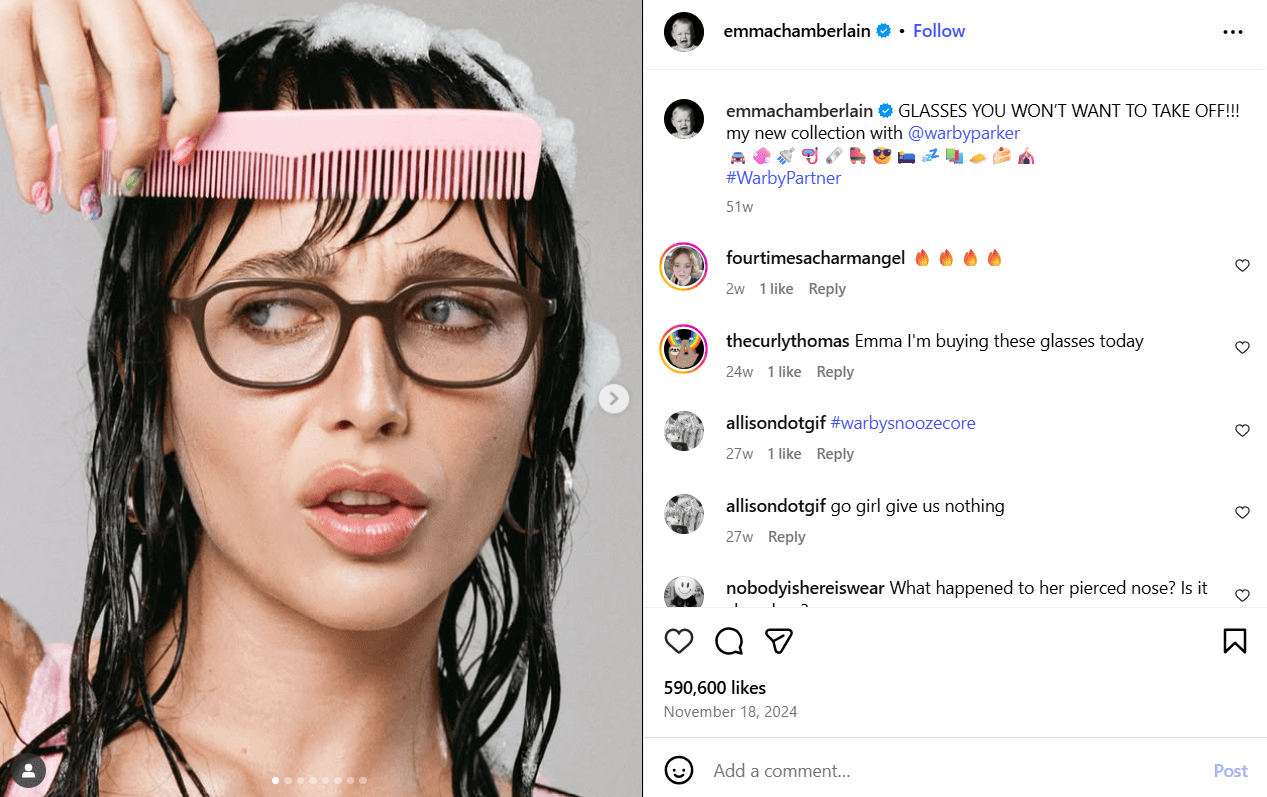Have you ever questioned if you really need influencer marketing for your business?
Many new businesses do, as influencer marketing and its credibility have been questioned a lot lately.
This may be because many people accuse some influencers of promoting a product they don’t actually use themselves.
Hence, we can say that influencer marketing has some drawbacks.
Short Summary
- Influencer marketing helps brands build trust by partnering with creators who have loyal, engaged audiences.
- Choosing the wrong influencer can hurt credibility; alignment with brand values is crucial.
- There are four influencer tiers, Mega, Macro, Micro, and Nano, each offering different reach, cost, and engagement.
- To find influencers, use social listening, niche hashtags, influencer platforms (like HypeAuditor or Upfluence), and analyze competitors’ collaborations with Social Champ.
- Approach influencers with personalized pitches, clear value exchanges, and specific deliverables while allowing creative freedom.
However, this mostly happens when a brand collaborates with the wrong influencer for marketing.
I mean, if you’re a cruelty-free brand, you shouldn’t collaborate with influencers who are seen wearing fur coats and leather boots in the first place.
Let’s take an example. Do you remember when Pepsi was criticized for the Kendall Jenner partnership?
That’s exactly what happens when you mismatch influencers in campaigns; it can hurt your brand.
Which is why I have created this guide to help you find influencers that are right for your brand.
So, let’s get started!

Every Missed Post Is a Missed Customer!
Get your content in front of the right eyes, every single time. Social Champ makes consistency effortless.
What Is Influencer Marketing?
Were you aware that 69% of consumers trust an influencer, friend, or family member instead of the information coming directly from a brand?
Now, you cannot hire everyone’s friends or family members to recommend your product to them, but you can surely collaborate with an influencer with the right audience.
But first, you need to understand what influencer marketing actually is!
It’s a marketing practice that takes place when your brand strategically partners with influential content creators (the “influencers”) to promote your product or service to their dedicated, engaged audience.
These creators spend years building a loyal community that genuinely values their opinions and advice.
When you collaborate with them, you’re tapping into their credibility and trust.
The influencer doesn’t just read an ad script; they weave your product naturally into their content.
It can be a YouTube video review, an Instagram story tutorial, a dedicated TikTok post, or a blog article. It doesn’t look like a classic billboard ad; it feels like a personal, trusted recommendation.
With this strategy, you find an influencer whose community is already interested in what you sell.
For example, if you sell sustainable skincare, you partner with a beauty content creator who also has similar values.
Featured Article: Learn Facebook Influencer Marketing in 2026
Why You Need to Find Influencers to Promote a Product?
Marketing today is harder than it ever was!
Your customers are constantly doomscrolling, and it’s difficult to grab their attention with a mediocre ad.
You need a trusted voice for your brand!
That’s the ultimate reason why you should partner with influencers, and here’s a breakdown of the three biggest reasons they are non-negotiable for product promotion:
-
They Bring Instant, Priceless Trust
Consumers today have a finely tuned “BS detector”; they’re skeptical of shiny, branded ads. And influencers have spent years building a genuine relationship with their audience.
When they recommend a product, it feels less like an ad and more like a personal endorsement from a friend.
-
You Can Target Your Ideal Customer
Traditional advertising casts a wide net, hoping to catch a few relevant fish. Influencer marketing, on the other hand, is like using a specialized spear.
You don’t just get a large audience; you get a perfectly segmented audience that is already passionate about your niche.
- If you sell high-end coffee equipment, you partner with a “coffee connoisseur” influencer.
- If you sell specialized coding software, you partner with a specific “tech review” creator on YouTube or a professional platform.
This targeted approach guarantees that the person seeing the promotion is already interested in what you offer, leading to much higher engagement and conversion rates.
-
They Are Content Creation Experts
It is not easy to create content for multiple platforms; it is a full-time job, and with a business to run, I don’t think you have that much time.
So when you partner with an influencer, you’re not just buying reach; you’re licensing their creative expertise.
Influencers know what works on their specific platform and for their unique audience.
For example, the skincare brand CeraVe worked with dermatologists and smaller skincare enthusiasts on TikTok and Instagram for years.
This positioned them as a trusted, expert-backed brand.
View this post on Instagram
Types of Influencers: Mega, Macro, Micro, and Nano
When you hear “influencer,” your brain probably jumps to a celebrity-status content creator.
But the truth is Kardashians are not the only influencers in the world, and there are four tiers of influencers.
Choosing the right tier is the most crucial step to find influencers that are right for you, as each one offers something totally different in terms of reach, cost, and authenticity.
Think of it like a pyramid: the people at the top are famous, and the people at the bottom are your super-engaged friends.

-
Mega-Influencers (1 Million+ Followers)
This is the big leagues. Mega-influencers are basically internet celebrities. Their followers number in the millions, and they offer unmatched scale and reach.
- What they offer: They are your go-to for massive brand awareness and making a splash on launch day. When they post, your product is instantly seen by an audience the size of a small country.
- The Trade-off: That massive reach comes with a massive price tag and typically a lower engagement rate (comments/likes relative to followers) because their audience is so broad. Their endorsement feels more like a celebrity feature than a personal recommendation.
For instance, @emmachamberlain started as a relatable vlogger but has grown into a major fashion and lifestyle icon. Brands partner with her to reach a huge, trend-setting Gen Z audience with content that is aspirational but still feels personal.

@emmachamberlain’s Collaboration Post With @warbyparker -
Macro-Influencers (100K – 1 Million Followers)
Macro-influencers are the professional tier.
They’ve built a large following through consistent, high-quality content and are often considered authorities in their general niche (like ‘tech’ or ‘travel’).
- What they offer: They strike a great balance between wide reach and solid professionalism. They usually have excellent production quality (think polished videos and perfect photos) and are experienced working with brand briefs.
- The Trade-off: While they are more focused than a Mega, their niche can still be broad. Their cost is high, but the content quality is usually flawless and ready to be used in your own advertising.
To take an example, let’s look at @diksharawat22. She creates lifestyle content and has over 250k followers. She can be the perfect fit for fashion and beauty brands.
View this post on Instagram -
Micro-Influencers (10K – 100K Followers)
This is often where the magic happens for conversions.
Micro-influencers have smaller, but fiercely loyal, communities built around a very specific niche (e.g., sustainable outdoor gear, gluten-free baking, or personal finance for doctors).
- What they offer: High engagement and deep trust. Their followers view them as an expert friend, so their product recommendations are taken seriously and often lead directly to sales. They are the most efficient for driving conversions.
- The Trade-off: You need to work with many of them to equal the reach of a single Macro-influencer. This means more relationship management for your team.
For example, @jasminetfluer on Instagram has 93.8k followers, and she makes book-related content, which makes her a good fit for publishers and authors.
View this post on Instagram -
Nano-Influencers (1K – 10K Followers)
Nano-influencers are the new frontier of word-of-mouth.
They are everyday people, your co-workers, neighbors, or customers, who simply love a niche and share their passions genuinely.
- What they offer: The highest engagement rates and purest authenticity. They are the perfect source for genuine User-Generated Content (UGC) because their posts are raw, honest, and look exactly like a recommendation from a friend. They are also incredibly budget-friendly.
- The Trade-off: Very limited reach per person, so you need a high volume of Nano-creators to make a meaningful dent in awareness.
For example, @silletholund has around 8k followers on Instagram and is perfect if you want a creator who creates UGC content.
View this post on Instagram
Best Ways to Find Influencers on Social Media
Now that you know all the types of influencers, you must be wondering how to find influencers on social media that actually good for your brand.
Here are some best practices that you can follow!
-
Start With Who’s Already Talking About You (Social Listening)
The most authentic and valuable influencers are often those who are already fans of your brand or are highly engaged in your product category.
The best practice is to start with social listening, a fancy term for monitoring conversations about your brand, industry, and competitors.
To make monitoring all those platforms feel super easy, consider leveraging a dedicated tool like Social Champ.
It helps you quickly monitor and track every mention of your brand and takes the stress out of digging, and lets you focus on building those great relationships!

You’re Missing Conversations That Could Make You Viral.
Join the talk as it happens, before your competitor does. Social Champ keeps your brand in the loop. Start your free trial now!
-
Master the Targeted Hashtag Hunt
A mass-market approach to hashtags is a waste of time; you need to target the niche of the niche.
Instead of searching for something broad like #fashion, hunt for specific, community-driven tags like #sustainablefashionfinds, #petiteootd, or #capsulewardrobetips.
These focused hashtags are where highly engaged micro-influencers reside, as they cater to a very particular audience.
-
Leverage Dedicated Influencer Marketing Platforms
Forget manually scrolling through profiles. Influencer Marketing Platforms are non-negotiable for scaled discovery and vetting.
These powerful tools act as searchable databases that allow you to filter creators by hyper-specific criteria that a manual search simply cannot handle.
To effectively answer the question of how and where you can find the right influencers, I recommend looking into platforms like:
-
Analyze Your Competitors’ Partnerships
One of the quickest ways to find proven influencers in your space is to see who your competitors are successfully working with.
Look closely at their social media profiles for sponsored content, often identified by clear tags like #ad or #partner.
Then, examine the engagement metrics on those specific posts. Which creators drove the most genuine comments and shares?
You can also use social listening tools to track which creators are consistently mentioning your competitor, not just for paid posts, but for organic discussions.

Want to Know How Your Competitors Are Performing?
Social Champ allows you to track your competitors and their strategy! Start your free trial now and start getting ahead of your competition!
How to Approach Influencers for Collaboration?
You have found the right influencer for a partnership, bravo!
But do you know what you have to say to them?
How will you convince them to partner with your brand?
And how do you plan to approach them?
Here’s what you need to do!
-
Write a Personalized Pitch, Not a Mass Email
Forget sending a generic “Dear Influencer” template. That goes straight to the digital trash bin.
When you reach out, you need to show them you’ve actually done your homework.
Reference a specific piece of content they recently created, maybe you loved their review of a competitor’s product or thought their last TikTok tutorial was hilarious.
Tell them exactly why their audience is the right fit for your brand.
This immediate personalization demonstrates respect for their work and proves that this isn’t a spray-and-pray marketing tactic.
Keep your initial email brief, professional, and easy to read on a mobile device, as many creators manage their communications on the go.
-
Detail the Value Exchange Upfront
The influencer needs to know exactly what they will get in return for their time and effort.
Don’t beat around the bush; clearly state what the partnership offers in the very first email.
This might be monetary compensation, a free product sample (often enough for Nano and some Micro influencers), or a combination of product plus an affiliate commission.
If you have a specific budget range, it’s helpful to share it, or at least ask about their standard rate card right away.
This avoids frustrating back-and-forth negotiations and shows you value their worth.
-
Be Clear About Deliverables and Timelines
Once the influencer expresses interest, you need to be precise about what you expect.
A vague ask like “post something about us” won’t cut it.
Your agreement should detail the exact deliverables, for example, “One 60-second TikTok video, three Instagram Stories with a swipe-up link, and one static grid post.”
You also need to clearly communicate the content approval process and the firm deadline for posting.
Remember, while you must outline your key messaging and legal requirements, always allow them creative freedom.
They know their audience best, and authentic content that feels natural to their feed will always perform better than something overly scripted by your marketing team.
Featured Article: The Power of Twitter Influencer Marketing in 2026
Conclusion
If you take just one thing away from this guide, let it be this: authenticity always wins.
Finding influencers isn’t a transactional marketing task; it’s a mission to find influencers who are the most trusted voices in your niche.
You need to stop chasing follower counts and start chasing engagement, relevance, and real advocacy.
By using smart tools like Social Champ and by pitching creators with personalized respect, you’re setting yourself up for a campaign that drives genuine, lasting customer loyalty.
Go find your advocates, empower their voices, and watch your brand thrive!




